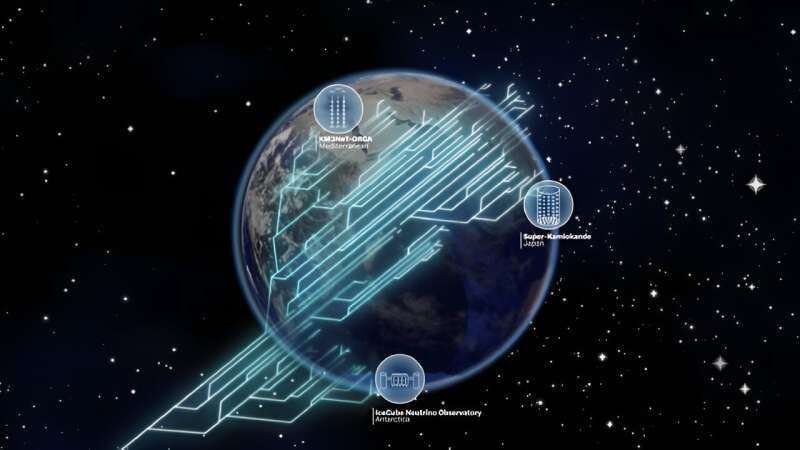December 27, 2023 report
This article has been reviewed according to Science X's editorial process and policies. Editors have highlighted the following attributes while ensuring the content's credibility:
fact-checked
peer-reviewed publication
trusted source
proofread
Ordering of neutrino masses may be revealed by measuring those produced in Earth's atmosphere

A group of physicists, three with Harvard University's Department of Physics and Laboratory for Particle Physics and Cosmology, and the fourth with the University of Liverpool, has found evidence suggesting that additional measurements of neutrinos generated in Earth's atmosphere could be used to reveal how the three types of neutrino masses are ordered.
In their paper published in the journal Physical Review X, C. A. Argüelles, I. Martínez-Soler, M. Jin and P Fernández, describe how they conducted an analysis of the expected sensitivities of current and near-future water/ice-Cherenkov atmospheric neutrino experiments as they may relate to the three types of neutrino oscillations.
Josh Spitz, a physicist at the University of Michigan, has published a News & Views piece in Nature outlining the work done by the team on this new effort.
Neutrinos are sub-atomic particles, and there are three known varieties; electron-neutrino, muon-neutrino, and tau-neutrino—its type is believed to be set when it is created. Neutrinos can be created in a variety of ways, such as during a supernova or other major astral event. Interestingly, they can also change from one type to another, for example when they pass through a planet. Such a changes is known as quantum mixing.
Scientists have been studying neutrinos with the hope that doing so will help to unlock some of the big mysteries that remain in physics, such as the nature of gravity and dark matter. As the team on this new effort notes, developing ways to more precisely measure neutrinos would lead toward a better understanding of how mixing works. One goal is to determine the masses of the three types of neutrinos.
Physicists study neutrinos in a variety of ways, such as by generating them using particle accelerator colliders, by observing them in nature, and by studying the means by which they are generated in Earth's atmosphere when cosmic rays collide with atmospheric atoms. It is on this third method that the research team has focused their efforts.
Current efforts to study such neutrinos typically involve building water or ice chambers with photodetectors sensitive enough to capture neutrinos as they collide with atoms in the tank. By studying the light pattern emitted during such collisions, researchers can determine the type of neutrino involved, its energy level and how far it traveled before the collision occurred.
By analyzing a large sample of such collisions and the data they have revealed thus far, the research team found that information is amassing a rate that should allow for determining the masses of the three types of neutrinos by the year 2030.
More information: C. A. Argüelles et al, Measuring Oscillations with a Million Atmospheric Neutrinos, Physical Review X (2023). DOI: 10.1103/PhysRevX.13.041055
Josh Spitz, Neutrino secrets could be revealed by Earth's atmosphere, Nature (2023). www.nature.com/articles/d41586-023-04085-0
Journal information: Nature , Physical Review X
© 2023 Science X Network





















